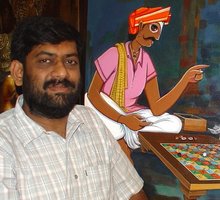Farewell My Dear Friend
Covid-19 has taken its toll of one of the brightest and amazingly talented son of Mysore.
Soft spoken and gentleness personified Narayanachar Dakshinamurthy (1980-2021) was the rising star in the rarefied field of gold and silver smithy creating some of the most stunningly beautiful treasures for temples and private patrons.
 |
| Dakshinamurthy with his parents |
A child prodigy, he had an innate ability to create and recreate masterpieces worthy of being family heirlooms. A chip of the old block, he continued the illustrious family legacy of his father late B.N. Narayanachar, paternal uncle octogenarian B.N. Channappacharya, maternal uncle late Bilikere Somachar and cousin B.C. Sreenivasa, all of them highly talented sculptors.
My association with Daksha (as he was called by family and friends) began in the year 1995 CE when I visited his house cum workshop bang in front of the police station in Mandi Mohalla. I had accompanied late P.R. Tippeswamy and my uncle late M.B. Singh to meet Daksha's father.
Tippeswamy hailed from a family (referred as Patel) of village headmen from Hartikote in Chitradurga district. He had vowed to donate five kalashas made of silver for the palanquin of the temple of his native village. The annual Jaatre (festival) was scheduled for the summer of 1995. While the discussions for the cost of silver, labour and time required were in progress, we were served tea. Sitting in one corner of the spacious hall right behind us, Daksha had sketched a pair of kalashas with filigree patterns along with the placement position of the pancha kalashas and silently handed over the same to his father. Tippeswamy was all excited.
While Narayanachar took out his ledger to jot down the finalised order, Daksha slinked away. Out of the huge bay window which opened out to the street, I caught a glimpse of him relishing a Jamoon at the small shop across the street perhaps savouring his success that his pattern had been approved. Daksha was just a lad of fifteen then, on his eighteenth birthday I approached him with a request to create a sixteen armed Mahisha Mardini which he finished after two years.
 |
| H.E. Governor of Karnataka Sri T.N. Chaturvedi conferring the award to Dakshinamurthy |
In the year 2006, Ramsons Kala Pratishtana had nominated him for the Kamaladevi Chattopadhyaya Award instituted by the Crafts Council of Karnataka and he was selected for the same and received the honours at Raj Bhavan, Bangalore, from the then Governor of Karnataka T.N. Chaturvedi. I was witness to this joyous event on 03-04-2007. I nurtured a wish that one day the same will be repeated at the Rashtrapati Bhavan. Alas, fate willed otherwise.
His innumerable creations adorn Mathas like Palimaru, Pejavara, Puttige, Sode apart from dieties and puja paraphernalia in well-to-do households of south Karnataka. His last commission was the Pattadevaru (principle deity) Chaturbhuja Kalinga Krishna (four armed Krishna dancing on the serpent Kaliya) for Paryaya Sri Adamaru Matha. He showed me the copper masterpiece which had to be recast in silver before Sri Krishna Janmashtami this year.
 |
| Venugopala. Silver idol, with gold and precious stone details, in Hoysala style. Created by Dakshinamurthy for a private collection. |
Daksha leaves behind his wife and two daughters. Tragically his mother passed away just ten days before succumbing to Covid-19.
 |
| Mahishasura Mardini. Silver idol with gold details. Hoysala style. Created by Dakshinamurthy. Deity being worshipped at Ramsons. |
Daksha’s never-say-die attitude and reassuring smile will be missed forever.


